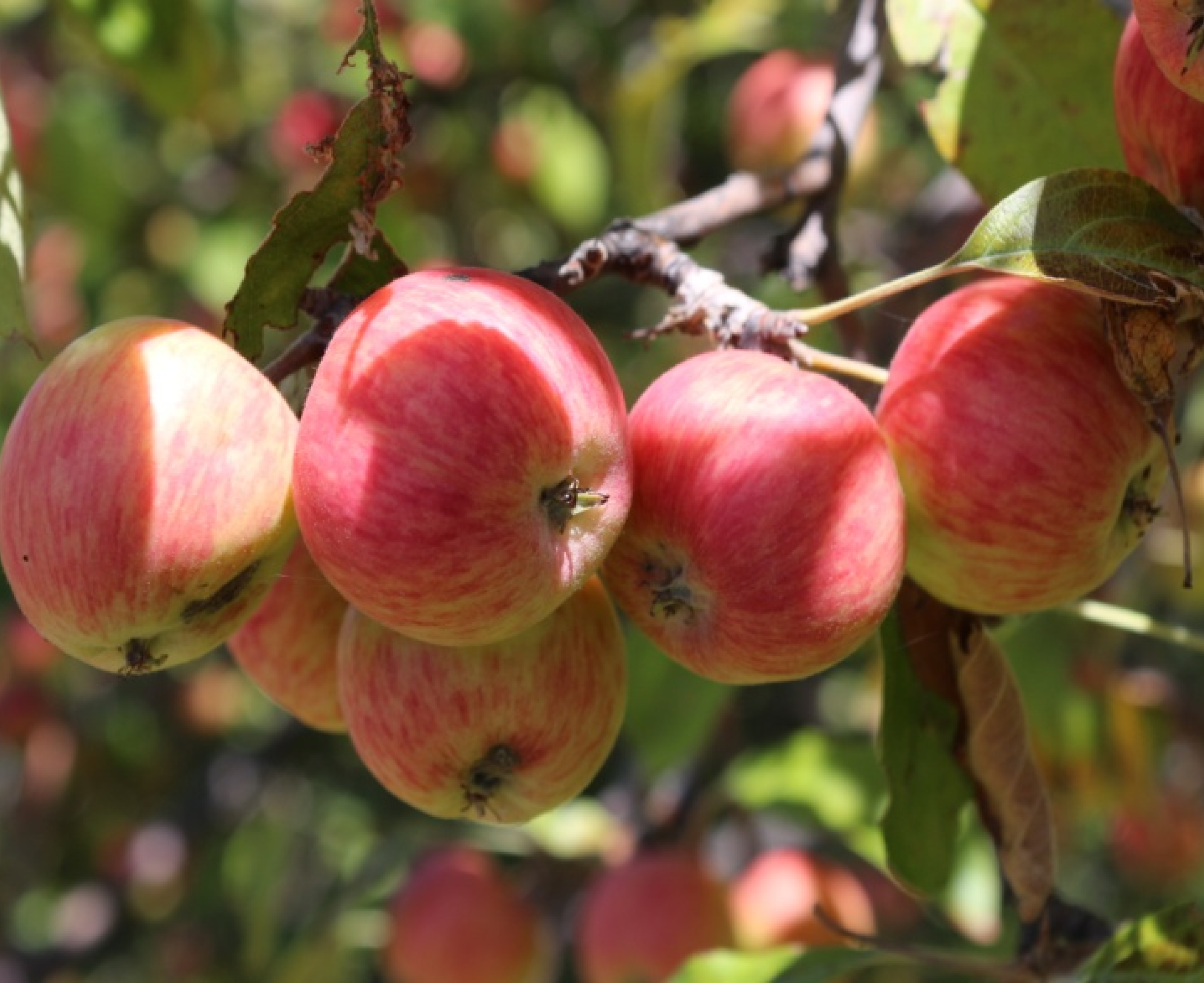
Sivers
Apple
Сиверс алмасы
Malus sieversii (Ledeb.) M.Roem.
1
The value of the taxon
in preserving the gene pool
Vulnerable. It is endemic. It is listed in the Red Book of Kazakhstan.
2
Distribution
It is found in the mountains of Tarbagatai, Dzungarian, Zailiysky, Talas Alatau and Karatau. On the territory of the Sairam-Ugam GNPP: Karzhantau ridges, Kaskasu gorge, Sairamsu, Saryaygyr, Burgulyuk, Ugam ridges, Kazygurt mountains.
Status. Vulnerable. Endemic.
The importance of the taxon in the preservation of the gene pool. It is listed in the Red Book of Kazakhstan.
Botanical description.
The type of Sivers apple tree is 6-7 meter tall trees with a raised, irregularly oval crown, in diameter capable of spreading up to 4 m. Leaves: prickly branches are decorated more often with pointed leathery leaves of obovate or oblong shape with small serrations along the edges. The leaf blades on the back side have a strong pubescence. The petioles holding the leaves are also pubescent. In autumn, the foliage acquires a bright yellow – green shade. Flowers and fruits: collected in a small-flowered umbrella inflorescence, the buds are colored pink. The medium–sized blooming flowers are white and pink. The first fruits ripen in August. Yellow – green with a blush, rarely red apples 2 – 5 cm in size, have a spherical, slightly flattened shape, bittersweet taste.
Winter hardiness: in the conditions of the middle zone, the species is hardy. The leaves are elliptical or rounded, pointed at the tip, serrated or saw-toothed along the edge, young – strongly pubescent, especially from below, adults – glabrous, glossy from above. Flowers in small-flowered shields on shortened shoots. The corolla is white or pink, 3-4 (up to 5) cm in diameter, 18-50 stamens, a pistil with 5 columns and stigmas and a lower ovary. The fruit is a small spherical or ovoid apple up to 5 cm in diameter. Blooms in April – May, simultaneously with the opening of the leaves. The fruits ripen in July – September. It begins to bear fruit from 5-10 years. One adult tree yields several tens and even hundreds of kilograms of fruit. Fruiting is periodic (harvest years alternate with lean years). In nature, it reproduces mainly by seed. In the distribution of seeds, the main place belongs to birds and mammals.
Distribution. It is found in the mountains of Tarbagatai, Dzungarian, Zailiysky, Talass Alatau and Karatau. On the territory Sairam-Ugam State National Nature Park: range of Karzhantau, Kaskasu gorge, Sairamsu, Saryaygyr, Burgulyuk, range Ugam, Kazygurt mountains.
Habitats. The apple tree begins to occur in plant communities from a height of 1300 m in single individuals in mixed-grass-hawthorn-apricot communities. On leached chernozems by northern exposures. At an altitude of 1400-1450 m, the apple tree dominates the shrub-hawthorn-apple communities. It grows on mountain slopes, as well as in valleys and along the bottoms of gorges. Single apple trees are also found on the dry southern slopes.
Using.
Dried leaves were used as a substitute for tea. Fruits are valuable feed for pigs. Honey-bearing plant. Bees collect nectar and pollen.
In Kazakhstan, the Sivers apple tree was used as a rootstock for cultivated varieties. In addition to the historical value, it has great biological significance. The unique strong DNA structure, and most importantly – not spoiled by refined varieties, has incredible stability, both to various diseases and to a critical low temperature. It has also been established that the fruits of wild apple trees contain many biologically active substances and trace elements, which is of great value for the food industry, because cultivated varieties have lost a number of valuable qualities of their wild predecessors.
